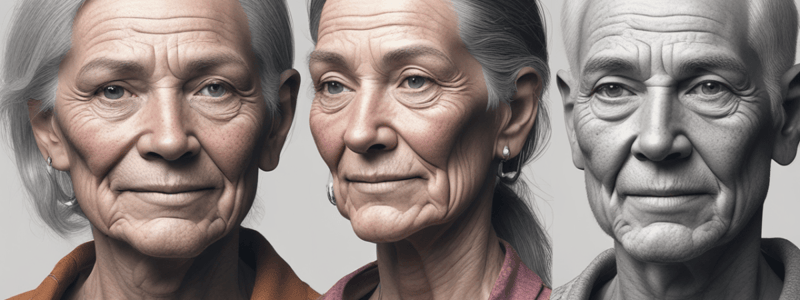Podcast
Questions and Answers
What is a key issue in adult development and aging according to the text?
What is a key issue in adult development and aging according to the text?
- Plasticity of adult development
- Nature vs. Nurture controversy
- Methods of research design (correct)
- Stability-Change debate
Which aspect of adult development focuses on whether adults change over time or not?
Which aspect of adult development focuses on whether adults change over time or not?
- Continuity-Discontinuity (correct)
- Nature-Nurture conflict
- Plasticity of capacity
- Sociocultural age roles
Emerging adulthood refers to a stage when individuals are:
Emerging adulthood refers to a stage when individuals are:
- Fully adults
- Teenagers
- Children
- Not adolescents but not fully adults (correct)
In the context of adult development and aging, what is plasticity referring to?
In the context of adult development and aging, what is plasticity referring to?
What does the nature-nurture controversy address in the study of adult development and aging?
What does the nature-nurture controversy address in the study of adult development and aging?
Which age stage is characterized by life being intense, demanding, and rewarding?
Which age stage is characterized by life being intense, demanding, and rewarding?
What are some common chronic conditions discussed in the text related to adult development and aging?
What are some common chronic conditions discussed in the text related to adult development and aging?
What are the main biological systems discussed in relation to adult development and aging in the text?
What are the main biological systems discussed in relation to adult development and aging in the text?
Which model is mentioned in the text that emphasizes the importance of environmental factors in understanding behavior changes across adulthood?
Which model is mentioned in the text that emphasizes the importance of environmental factors in understanding behavior changes across adulthood?
What concept refers to the ability of an individual to maintain their integrity and adapt positively to significant adversities or changes in the environment?
What concept refers to the ability of an individual to maintain their integrity and adapt positively to significant adversities or changes in the environment?
In the context of adult development and aging, what types of disorders are discussed under the umbrella of psychopathology?
In the context of adult development and aging, what types of disorders are discussed under the umbrella of psychopathology?
What aspects are linked in the Loss-Continuum Concept as described in the text?
What aspects are linked in the Loss-Continuum Concept as described in the text?
What is one of the challenges in studying adult development according to the text?
What is one of the challenges in studying adult development according to the text?
Which type of study design compares various age groups at a single point in time?
Which type of study design compares various age groups at a single point in time?
What is a key characteristic of cohort effects as discussed in the text?
What is a key characteristic of cohort effects as discussed in the text?
Which variable reflects differences caused by age-related changes?
Which variable reflects differences caused by age-related changes?
In which type of design would researchers compare 20 year olds, 30 year olds, 40 year olds, and 50 year olds at a single time point?
In which type of design would researchers compare 20 year olds, 30 year olds, 40 year olds, and 50 year olds at a single time point?
What is the aim of a cross-sectional design in studying adult development?
What is the aim of a cross-sectional design in studying adult development?
Flashcards are hidden until you start studying
Study Notes
Life-Span Perspective
- The Life-Span Perspective (LSP) helps place adult development and aging into the context of the whole human experience across life.
- It involves assessing the functioning of organ systems, psychological age, and sociocultural age.
Psychological Age
- Functional level of psychological abilities used to adapt to changing environmental demands.
- Examples include memory, intelligence, and motivation.
Sociocultural Age
- The set of roles an individual adopts relative to other members of the society and culture to which they belong.
- Based on customs, language, style of dress, etc.
Stages of Adulthood
- Emerging Adulthood: Individuals are not adolescents but not yet fully adults.
- Established Adulthood: The period between ages 30 and 45 when life is intense, demanding, and rewarding.
Key Issues in Adult Development and Aging
- How do we study adult development and aging?
- Understanding methods of research design is essential in this area.
- Many challenges exist, and specific designs address specific questions.
Controversies in Development
- Nature-Nurture: Genetic inheritance or environmental influences?
- Stability-Change: Do we change as adults over time or not?
- Continuity-Discontinuity: If change occurs, is it a smooth evolution over time or abrupt shifts?
Research Methods
- Case studies: Single individual, good for new or rare areas, but limited generalizability.
- 3 "Building Block" Variables to Consider:
- Age effects: Reflect differences caused by age-related changes.
- Cohort effects: Changes caused by different experiences and circumstances of a particular generation or group.
- Time of measurement effects: Differences due to sociocultural, environmental, or historical events during the time of data collection.
General Designs for Research
- Cross-sectional designs: Compare various age groups at a single point in time.
- Longitudinal designs: Follow a single group over time.
- Sequential designs: Combination of cross-sectional and longitudinal designs.
- Microgenetic study: A type of longitudinal design.
Challenges in Studying Adult Development
- Identifying and separating age, cohort, and time of measurement effects is not easy since they are often confounded with one another.
Studying That Suits You
Use AI to generate personalized quizzes and flashcards to suit your learning preferences.



